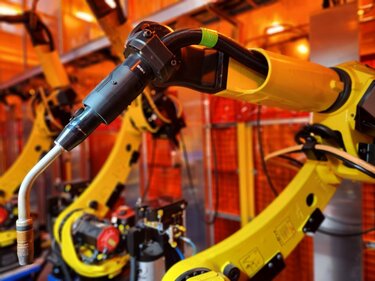Is a Water-Cooled Robotic Welding Gun Necessary?
Robotic welding operations can be tough on equipment. The heat from the welding arc, along with reflective heat from the base material and resistive heat from the electrical components, can wear on consumables and the robotic welding gun. In some cases, implementing a water-cooled robotic MIG gun is the answer, but many times an air-cooled model can handle the job.

Water-cooled robotic welding guns are designed to handle high amperage applications, typically above 400 welding amps at 100% duty cycle. They are used for longer welds and multiple passes on thicker material with larger welding wire diameter (above 0.052 inch), such as those found in heavy equipment manufacturing.
That said, water-cooled guns are more expensive upfront compared to their air-cooled counterparts and require the additional expense of a water cooler. These guns operate by circulating a coolant from the water cooler through hoses in the power cable to the gun and neck, then returning the coolant to the cooler to release the absorbed heat. Due to the complexity of this design, there are more potential failure modes, so maintenance and repairs cost more over the life of the gun. Given the current shortage of skilled labor, it can be difficult to find welding operators who can take on these tasks. That can lead to downtime and lost productivity.
For these reasons, companies need to ask: Is a water-cooled welding gun necessary? Often, companies may be using this type of gun because it’s what’s always been on the plant floor, or they think they need the extra protection from the heat of the application. They may even be trying to protect the consumables from overheating. That doesn’t mean that a water-cooled welding gun is the best option.
When air-cooled makes more sense
Air-cooled robotic welding guns use the ambient air, shielding gas and arc-off time to dissipate heat. Their design is simple and easy to maintain since they have fewer parts than water-cooled models. A lower upfront cost and less expense to care for the guns make them an appealing alternative to a water-cooled gun. And, in several instances, these guns are a better option for a welding operation.
Duty cycle factors into using an air-cooled robotic welding gun. Duty cycle refers to the number of minutes a welding gun can operate at full capacity in a 10-minute period without overheating. If the gun can operate the full 10 minutes, then it offers 100% duty cycle. However, many applications do not require 100% duty cycle and therefore wouldn’t benefit from a water-cooled gun that offers that capacity. In this case, it is possible to use a 350-amp air-cooled gun and run it at a lower duty cycle: for example, 50%. An air-cooled robotic MIG gun will heat up and plateau at a certain temperature. The operator overseeing the application will need to be cognizant of the duty cycle and welding duration and adjust the application accordingly.
In applications with shorter weld requirements, it’s also possible to configure a robotic welding cell to use air-cooled robotic welding guns. On a robotic line, there are often multiple robots welding at the same time. If one robot only welds for one minute and a second robot welds for two minutes, then the air-cooled gun on the first robot has time to cool down as it waits for the other robot to finish its weld. In essence, the robotic welding gun on the first robot would be working at 50% duty cycle as compared to the second robot.
For companies using a water-cooled robotic MIG gun to keep consumables from overheating, a simple change of consumable type combined with an air-cooled gun is a better, and less costly, option. Consider changing from a copper contact tip to a chrome zirconium, since it can withstand heat better. Also, high-performance consumables like AccuLock™ HDP contact tips can significantly extend tip life, even in hard pulsed robotic welding applications. They can last six to 10 times longer than copper and chrome zirconium tips. While these contact tips have a higher upfront cost, the lower expense of an air-cooled robotic welding gun means the reduction in downtime and higher productivity saves money in the long term.
Simplifying the robotic welding operation
The goal of investing in robotic welding is to increase productivity, improve quality and reduce costs. Using an air-cooled robotic welding gun, when possible, can help companies gain these benefits. The lower upfront cost and total cost of ownership of this equipment means a better bottom line.